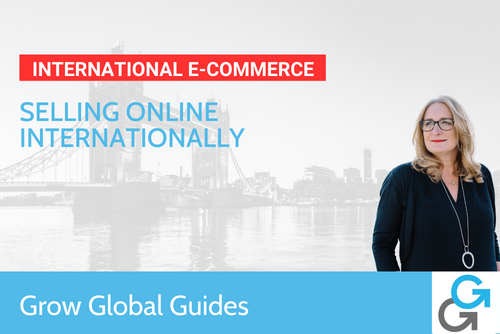Grow Global Guide To Selling Online Internationally
Selling online internationally is, let’s face it, an opportunity that is just too good to miss.
With even a small percentage of overseas orders, the potential to propel your sales revenue from international markets to another level is well worth the investment in putting the building blocks of a good international e-commerce strategy in place.
Which international markets should I select?
Think further afield than your traditional export markets and look at the number of internet users online. Although the web is thought more as a US thing due its early adoption for business, the largest number of internet users is actually in Asia and is growing fast. Furthermore, even though English is still just about the most popular language on the web, there will soon be more Chinese pages on the internet than English pages.
How do I research new geographic markets?
Different customers have different preferences within the UK and this holds true – and may even be more important – when looking at potential international customers. Think about everything up front so you make the right decisions on everything from evaluating the political and business environment through to checking out social media platform and mobile phone usage.
How can I build my online strategy?
Selling online doesn’t just mean having your own full e-commerce website – there are plenty of other ways to sell your products and services in other countries, many of which are low risk and allow you to test the water. You can add your products to an online marketplace like Amazon or Etsy, or set up an e-commerce website to showcase your product pages. For fast visibility in local search engines, add your products to a local agent or distributor’s website or set up a global social media presence.
How do I choose the right e-commerce platform?
If you’re going to take the e-commerce route, then the market is full of companies vying for your attention and promising to build you the best e-commerce system yet. Stand back and produce a specification of your requirements and evaluate what’s out there. Be sure to pick an online platform that will be able to support you as you expand internationally, supporting language pages, multiple currencies, different payment systems, delivery options and sales tax rates. Take a look at things like Magento and Shopify - or add an e-commerce module to your existing content management system if your website is built in Wordpress (you don’t necessarily need to start again). Also, make sure that it will integrate with any stock, finance or customer relationship management systems you already have in place.
Should I adapt my content for international customers?
To appeal to local customers and to be found in local search engines you will have to localise and translate your online content to have local language content dedicated to each country you are planning to sell into. Furthermore, you will have to customise your online content to local cultures and local tastes, including the messages, the copywriting, the images and videos. International customers are more likely to buy from you if you do this.
Do I need local payment methods?
We are very advanced and indeed trusting in e-commerce in the UK – one of the world’s leading e-commerce nations. We’ll quite happily part with quite a lot of cash on our credit cards and know that our goods will (normally) arrive. Many cultures are very distrustful of credit cards and usage is much lower. In this case, it is good to allow the prospect of customers paying by direct transfer or local payment systems. While PayPal is truly global and accepts most currencies, other specialist payment systems include Alipay in China, MPesa in Kenya as well as many others. It is an area that still needs a lot of thought. Customers may hop off to a competitor if they don’t see their preferred payment method.
Is there anything else I should research?
Bring everything in the whole marketing, selling, operations and logistics process into question when you are going international. Don’t assume everything will be the same. Don’t assume anything will be the same. Look into regulatory compliance, selling regulations, exchange rates, local legal requirements, customs documents to name but a few areas that will need your attention.
Despite the amount of research and work that you can put into building an international e-commerce strategy, the benefit at the end of the day is tremendous and can be more or less instantaneous. One company, The Travelwrap Company, started receiving web orders from Australia within weeks of setting up dedicated pages and another client Coral Turner Couture secured a private design client in Dubai within four days of starting to optimise her website for international trade.

